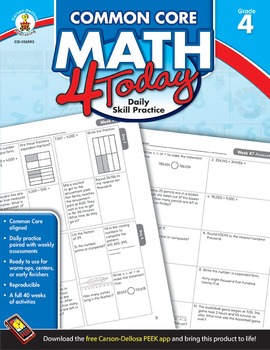Common Core Math 4 Today Grade 4 104593-EB
- PDF
What educators are saying
Description
Build a foundation and focus on what matters most for math readiness with Carson Dellosa's Common Core Math 4 Today: Daily Skill Practice for fourth grade. This 96-page comprehensive supplement contains standards-aligned reproducible activities designed to focus on critical math skills and concepts that meet the Common Core State Standards.
Each page includes 16 problems to be completed during a four-day period. The exercises are arranged in a continuous spiral so that concepts are repeated weekly. An assessment for the fifth day is provided for evaluating students' understanding of the math concepts practiced throughout the week. Also included are a Common Core State Standards alignment matrix and an answer key.
Play Video About Series: Common Core 4 Today Series Video
The link for the e-book is here: Common Core Math 4 Today Grade 4 E-Book
*****************************************************************************
Other products you may be interested in:
Common Core Connections Math Grade 4
Kelley Wingate Math Practice Grade 4
Applying the Standards Math Grade 4
*****************************************************************************
Customer Tips:
How to get TPT credit to use on future purchases:
• Please go to your My Purchases page (you may need to login). Beside each purchase, you'll see a Provide Feedback button. Simply click it and you will be taken to a page where you can give a quick rating and leave a short comment for the product. Each time you give feedback, TPT gives you feedback credits that you can use to lower the cost of your future purchases. We value your feedback greatly as it helps us determine which products are most valuable for your classroom.
Be the first to know about new products, freebies, and sales:
• Look for the green star next to the Carson-Dellosa store logo and click it to become a follower. You will now receive email updates about this store!
*****************************************************************************





